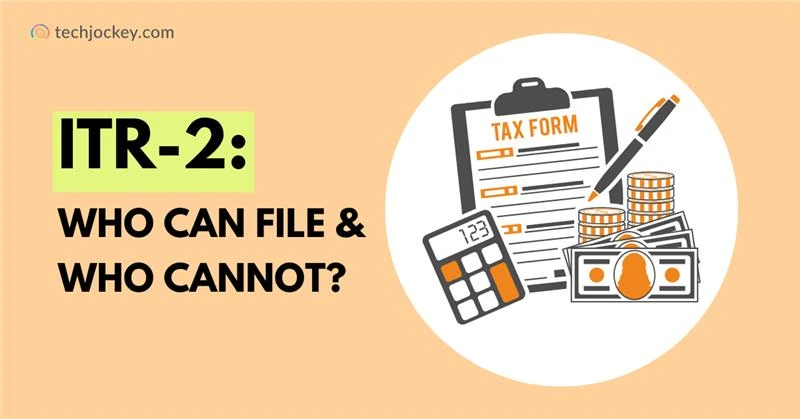As one size doesn’t fit all, the same goes for ITR forms. There are multiple ITR forms that are made for different taxpayers. Some taxpayers earn money only from salaries, some have other sources like property, capital gains, or investments outside India.
ITR-2 is one of the multiple types of ITR forms; each one has different eligible taxpayers.
It is meant for individuals and Hindu Undivided Families (HUFs) who earn from non-business income. ITR-2 is the right form for you if you have capital gains, multiple house properties, or if you earn money from abroad.
This blog will cover:
- What is ITR-2?
- Who can file Form ITR-2?
- Who cannot file the income tax return form 2?
- Key changes in AY 2025-26
- Due date of ITR-2
What is ITR-2?
“ITR-2 is an Income Tax Return form that is for individuals and Hindu Undivided Families (HUFs) who do not earn money from any business or profession.”
This form is a lot different from ITR-1 as it’s a little complicated because it covers a wider range of income sources and complex financial situations.
Who Can File ITR-2 for AY 2025-26?
You can file ITR-2 if you are an individual or belong to a Hindu Undivided Family and earn income from the following:
- If your total income is more than INR 50 lakh.
- If you receive income from a salary or, pension, regardless of the employer count or size of salary.
- If you own multiple properties and you earn from them, whether rented or from any other source of income from that property.
- If you generate income from Capital Gains, like stocks, mutual funds, or selling a property. In this, both short and long-term gains are covered.
- If you earn income from foreign investments.
- If you win money from the lottery or horse races, etc.
- If you have other sources of income, like dividends from shares or bank interest.
- If agricultural income is more than INR 5000.
- If you are a Non-Resident Indian (NRI) or a Resident but Not Ordinarily Resident (RNOR).
- If you are a director in a company or have invested in unlisted equity shares at any point in the year.
Example:
- If you are a salaried employee earning INR 60 lakh annually plus dividends and capital gains from mutual funds, you must file ITR-2.
- If you own two houses – one in Delhi and another in Pune, you must go for ITR-2.
- If you are an NRI earning rental income in India, you need to file ITR-2.
Who Cannot File ITR-2?
While ITR-2 is for most taxpayers, the ITR-2 applicability rules still exclude many from filing it. Here’s the list below:
- If you have income from a business/profession, and you earn from freelancing, startups, or a consultancy firm.
- If you have an income of less than INR 50 Lakh.
- Or if you are eligible for any other ITR form.
Note: The main difference is the business income. It’s different in different ITR forms. In that case, you will have to file ITR-3 or ITR-4, depending on your income type.
Release Date of ITR-2 for FY 2024-25
The Income Tax Department released ITR-2 utilities to make e-filing easier:
- Offline utility: Released on 11th July 2025
- Online utility: Released on 18th July 2025
This allowed taxpayers to start filing both offline (via utility) and online (via the e-filing portal). You can also use any third-party income tax software also to make filing ITR easy.
Due Date ITR-2 Filing in FY 2024-25
The last date for ITR-2 filing for the financial year 2024-2025 is 15 September 2025.
Earlier, the deadline was 31 July 2025, but the government extended it as some major changes were introduced in the ITR-2 form this year.
If in any case, you forgot or missed the deadline, you can still file the return with a late fee until 31 December 2025.
It is advised to pay ITR-2 on time to avoid any penalties and hassle.
Major Changes in ITR-2 for FY 2025-26
This year, the government has come up with certain changes in ITR-2 for better accuracy and compliance. Below are the updates:
- Taxpayers must now report capital gains separately based on whether the asset was transferred before or after 23rd July 2024.
- From 1st October 2024, taxpayers can claim capital losses on share buybacks only if the related dividend income is reported under “Income from Other Sources.” There is an addition of a new field in the Capital Gains schedule to record these losses.
- You have to report detailed asset/income information only if your total income is more than INR 1 crore. Earlier, the requirement was INR 50 lakh.
- Taxpayers must now provide specific details of deductions under Sections 80C, HRA (10(13A)), etc., instead of lump sum entries.
- You must mention under which TDS section tax was deducted to allow better matching and reconciliation.
Final Thoughts
So, what is ITR-2? It is the perfect form for individuals and HUFs without any business income but other complex income sources.
Here’s a short summary:
- Choose the form ITR-2 if your income is from capital gains, rent from multiple properties, foreign assets, or if your income is more than INR 50 lakh.
- Do not use ITR-2 if you earn from a business.
- The due date for filing ITR-2 is 15 September 2025.
- Be up to date with the new changes in ITR by the government.
Filing ITR-2 on time will help you maintain good financial records and get loans in the future if required.
Mehlika Bathla is a passionate content writer who turns complex tech ideas into simple words. For over 4 years in the tech industry, she has crafted helpful content like technical documentation, user guides, UX content, website content, social media copies, and SEO-driven blogs. She is highly skilled in... Read more









